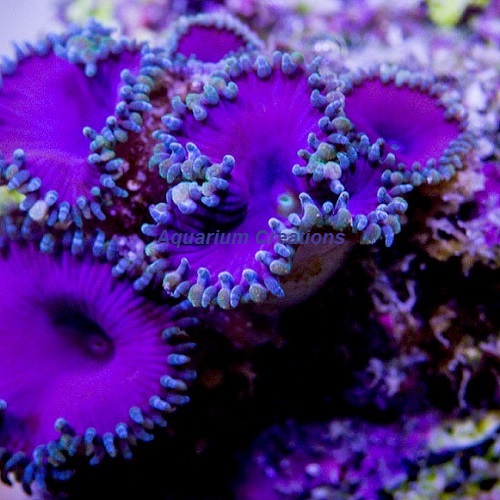Purple Death palys are an eye catcher and now their back! These Palys are a celebrated favourite amongst reef keepers. With their amazing purple glow it sure can put reef aquarist's in a daze. The colors on the Purple Death can vary depending on tank conditions but ideal colors for this coral is an electric purple which photograph well like the one above. Please keep in mind these palys do slime when stressed and they are more toxic than most zoas – so when handling do be careful. You do not have to be a great aquarist to keep the Purple Death Palythoa's. They thrive in just about any environment you throw at them. They do well in fast to slow current and can be acclimated to a wide range of lighting conditions. Like all of our polyps they are aquacultured specimens, many generations removed from the original wild starter colonies.
Keeping your parameters at the standard level will help these corals stay happy. Set your salinity between 1.024 and 1.026. Your pH should range around 8.3 and your temperature should stay between 77 and 82 degrees Fahrenheit. Palythoas in general require minimal lighting, but the Purple Death Paly seems to like slightly stronger lighting. The flow rate is not important, but their tentacles extend differently in various types of flow. They can sting other corals so leaving space around them is a good idea. They generally do not bother other Palythoa species but can outgrow or be outgrown by faster growing species.
Aggressiveness
They are a semi aggressive coral. They can sting other corals so leaving space around them is a good idea.
Water flow
They do well in fast to slow water flow.
Lighting
Palythoas in general require minimal lighting, but the Purple Death Palys seem to like a little stronger lighting. Any lighting will work as long as the proper level of light is provided. If a Par meter is available the appropriate lighting level is anywhere from a Par 100 all the way to a Par 150. For lighting spectrum use between a 14-20K color spectrum for your bulbs for best coloration.
Placement
Palythoa's may be placed anywhere which provides the required water flow and lighting level.
Diet and Feeding
Palythoas are the Venus Fly Trap of the sea. They happily accept mysis shrimp, tiny pcs. of squid, or any other chopped up meaty foods. They will also accept smaller foods like plankton. The more you feed them the faster they will grow. How do they know they are being fed? They contain a nerve net that senses vibration and things that come into contact with them. This often triggers them to close up as a defense mechanism or for consuming prey.
At night time Palythoa corals are usually closed unless you have a bright moonlight on or even if the room light is on. Any trace of light can keep them open all night. This may cause them to be stressed, but that is unlikely. The hardiness and growth rate of these corals make great propagators. You can take a frag of 8 polyps and turn it into 8 frags of 3 polyps within a couple months, thus making more than your money back.
Caution
One of the most fascinating aspects of the zoanthids is also one of the most deadly. Palythoas secrete a poison through their mucus known as palytoxin. Palytoxin is extremely dangerous, and it affects humans in a very adverse way. What this toxin does is mess with the cells of the heart, destroying their ion regulatory systems. The toxin enters the system via open wounds, ingestion, and injection. If there is no open wound, the skin becomes very irritated. Because of the lack of treatment, what is highly recommended with these creatures is to wear protective gear, such as gloves and goggles, and to use tongs which will help distance the creature from any contact with the skin.
|



